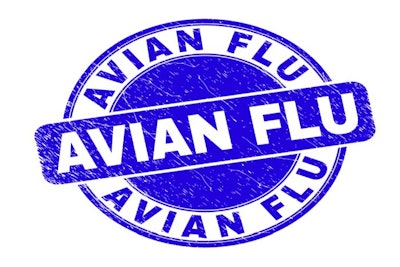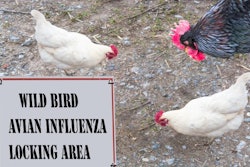
With eight states in Europe reporting cases of highly pathogenic avian influenza (HPAI) in poultry since mid-October, early signs are that the winter of 2021-2022 will be another challenging one for the region’s poultry sector.
While the significance of the difference is uncertain, H5N1 serotype is the dominant HPAI serotype this winter. Last year, the majority of cases were positive for the H5N8 variant.
As of November 7, a total of 1,219 HPAI outbreaks in poultry had been reported by 19 European states so far this year. This is according to the latest update of the Animal Disease Information System of the European Commission (EC).
This is a jump of 27 since the previous update from the EC, dated October 23. Accounting for these additional outbreaks were Denmark, Germany, Italy, the Netherlands and Poland.
For comparison, a total of 442 outbreaks of HPAI in poultry were registered through the EC system in 2020. In that year, cases were reported by 16 states, and Hungary was the worst affected (273 outbreaks).
HPAI hits Italy’s commercial poultry sector
Since mid-October, veterinary authorities in Italy have officially registered 11 outbreaks of HPAI linked to the H5N1 virus serotype.
Latest report to the World Organisation for Animal Health (OIE) outline seven new outbreaks starting between October 29 and November 4.
As with the earlier outbreaks, all were in the province of Verona in the Veneto region. Affected were five flocks of fattening turkeys (each with 15,000-40,000 birds), as well as 184,000 laying hens, and 85,000 broiler chickens.
Since the report was submitted to the OIE, further outbreaks have occurred in Italian poultry flocks. Latest update from the European Reference Lab for avian influenza, IZSVe indicates that these affected six more turkey flocks, as well as laying hens and broilers. Furthermore, first cases appear to be occurring in other parts of the country. The HPAI virus serotype had not yet been identified.
At the end of October, Italy registered its first HPAI cases of the winter.
Around the same time, a commercial ostrich flock in Verona province tested positive for a low-pathogenic avian influenza (LPAI) virus of the H5N2 serotype, also according to the IZSVe.
Six new outbreaks on Poland’s poultry farms
Since the start of November, Poland’s chief veterinary office has reported six outbreaks of HPAI in commercial poultry flocks. At each location, presence of the H5N1 HPAI virus has been detected.
These represent the first cases of the disease in the country for three months.
In total, the latest outbreaks have affected almost 646,000 poultry. These include four flocks of fattening turkeys and one of broiler chickens in the same county in the central-eastern province of Mazovia. Also hit by the disease was a mixed flock of meat turkeys and fattening geese in the western province of Lubusz.
In addition, birds in a non-commercial poultry flock also positive for this virus at the start of November. In the southern province of Silesia (Slaskie), around 130 of the 384 birds of mixed species died.
More Dutch poultry flocks hit by HPAI
Immediately after the season’s first HPAI outbreak at the end of October, the Dutch agriculture ministry strengthened disease control measures. These included an order to keep commercial poultry housed.
Since the H5N1 virus variant was detected in the organic layer flock in Flevoland, infections in a further three poultry flocks have been reported to the OIE. These included one flock of meat ducks in same province, as well as one of broiler chickens and a backyard in North Holland.
These bring to four the number of confirmed outbreaks in the country so far. Directly impacted are more than 151,000 poultry.
Since the OIE notification, the agriculture ministry for the Netherlands has reported the detection of an H5 avian flu in another laying flock. Comprising around 48,000 birds, this is located in Lutjegast in the province of Groningen. The exact serotype and pathogenicity of the virus are under investigation.
Furthermore, in the province of Friesland, around 200 water birds were culled last week after testing positive for an H5 avian flu.
Denmark register first HPAI cases in poultry
For the first time this winter, poultry in Denmark have tested positive for HPAI.
First to be affected was a commercial flock of 27,600 birds in the municipality of Slagelse on Zealand. Presence of the H5N1 virus variant was confirmed there.
Affected was a turkey flock, according to Danish Veterinary and Food Administration.
Within a few days, a mixed backyard flock in the same area also tested positive for the virus. It was located within one kilometer of the farm.
HPAI confirmed in poultry in two states in northern Germany
Over the past week, the veterinary authority for the state of Brandenburg has registered two outbreaks of HPAI with the OIE.
Presence of the H5N1 HPAI virus was confirmed firstly in a mixed backyard flock in the district of Spree-Neiße on November 1. The following day, a similar flock in Oberspreewald-Lausitz also tested positive for this variant. Of the total of 307 poultry in these two flocks, 148 died and the rest have been destroyed.
HPAI virus was last detected in Brandenburg in June of 2021.
In late October, a number of wild birds tested positive for the same virus subtype in the neighboring northeastern state of Mecklenburg-West Pomerania.
Last week, the first domestic poultry in this state tested positive. Affected was a backyard flock of 27 poultry, three of which died, while the rest have been destroyed.
Eastern Europe: new cases in Kazakhstan, Russia
In Kazakhstan, the number of outbreaks of HPAI linked to an unspecified H5 serotype during the last week of September has risen to four.
Latest to be reported to the OIE was an outbreak in a backyard flock of 160 poultry in the northern region of Akmola. Now affecting a total of more than 5,000 birds so far, previous cases were also detected in North Kazakhstan and the central-western region of Aktobe.
In the Kirov region of Russia, the H5N1 HPAI virus has been detected for the first time, according to the latest official report to the OIE.
Around 800 birds died out of a flock of more than 422,000 chickens at the end of last month.
Meanwhile, in the Volga River basin, birds in four backyard flocks have tested positive for an H5 HPAI virus. Three were located in the Orenburg region, and one in Saratov. These bring to 20 the number of HPAI outbreaks in the area since September, directly impacting more than 4,000 poultry.
EC does not monitor the animal health situation in Kazakhstan, Russia, or the U.K. through its animal health system.
Prevention Zone declared across Great Britain
As the HPAI situation developed in the United Kingdom (U.K.), more birds — both wild and domestic — have tested positive for the virus.
In response, an Avian Influenza Prevention Zone (AIPZ) has been declared across the whole of England, Wales and Scotland by the agriculture department, Defra.
Since the imposition of the AIPZ, all bird owners are required to follow strict biosecurity measures in order to protect their flocks from the disease. For those with more than 500 birds, measures include restricting access for non-essential visitors, and workers must change clothing and footwear before entering poultry houses or ranges. Furthermore, vehicles on the site must be cleaned and disinfected regularly.
So far, there is no requirement for poultry to be kept housed. However, Defra reports that the chief veterinarians will keep this situation under review.
Over the past week, two new outbreaks of HPAI in poultry in the U.K. have been registered with the OIE. The H5N1 virus subtype was detected in two non-commercial poultry flocks — one in Wrexham in Wales, and one in Angus in Scotland. They bring to three the number of HPAI outbreaks in poultry so far this winter, involving a total of 109 birds.
Bird flu risk level raised again in France
With evidence of the growing threat of HPAI elsewhere in Europe, the French agriculture ministry raised the risk level to the nation’s poultry sector to “high” last week. This will involve the strengthening of measures to protect poultry farms across the country, according to the minister, Julien Denormandie. Together with local authorities and professionals, the ministry is stepping up crisis management systems.
Among the measures to be imposed as a result of the high-risk level are the housing of commercial poultry flocks. For backyard owners, outdoor ranges are to be covered by netting to reduce the risk of contact with wild birds. There is also a requirement for poultry to be monitored daily for any signs of ill-health.
Furthermore, there is a nationwide ban on poultry gatherings and pigeon racing, and vaccination of birds is compulsory at zoos unless they can be confined or enclosed by netting.
Over last winter, 488 HPAI outbreaks were confirmed in French poultry flocks, directly impacting more than 2.4 million birds. Around 3.5 million poultry — mainly ducks in the southwest of the country — were culled to prevent further spread of the infection.
Only in early September did the authorities declare the HPAI situation resolved in France. Since then, isolated cases involving the H5N8 and H7N7 HPAI virus variants in wild birds and non-commercial poultry flocks appear to be under control.
Czech Republic declares avian flu “resolved”
Over the past week, the national animal health agency has declared to the OIE that the HPAI situation has been resolved in the Czech Republic.
Just one outbreak linked to the H5N1 virus variant was reported. Affecting a backyard flock, this occurred at the end of September, and no new cases have been detected since that time.
Overview of HPAI in European wild birds
So far this year, 29 countries in Europe have registered a total of 1,790 HPAI outbreaks in wild birds with the EC (as of November 7).
An increase of 57 since the previous edition to October 23, this figure compares with a total of 756 outbreaks in 13 of the region’s states during the whole of 2020.
Over the past two weeks, new outbreaks of HPAI in wild birds have been reported to the EC by the Czech Republic, Denmark, Finland, Germany, the Irish Republic, the Netherlands, and Sweden.
Based on reports to the OIE, all recent outbreaks in Europe have been linked to the H5N1 serotype of the HPAI virus.
For the Czech Republic, the state of Bavaria in Germany, the Irish Republic, the Netherlands and Sweden, the latest cases are the first of this winter season.
In addition, wild birds in Russia’s Rostov region have tested positive for an H5 HPAI virus, according to the OIE report. Furthermore, the H5N1 virus variant has been detected in a number of wild birds across the U.K. since mid-October.
View our continuing coverage of the global avian influenza situation.
















